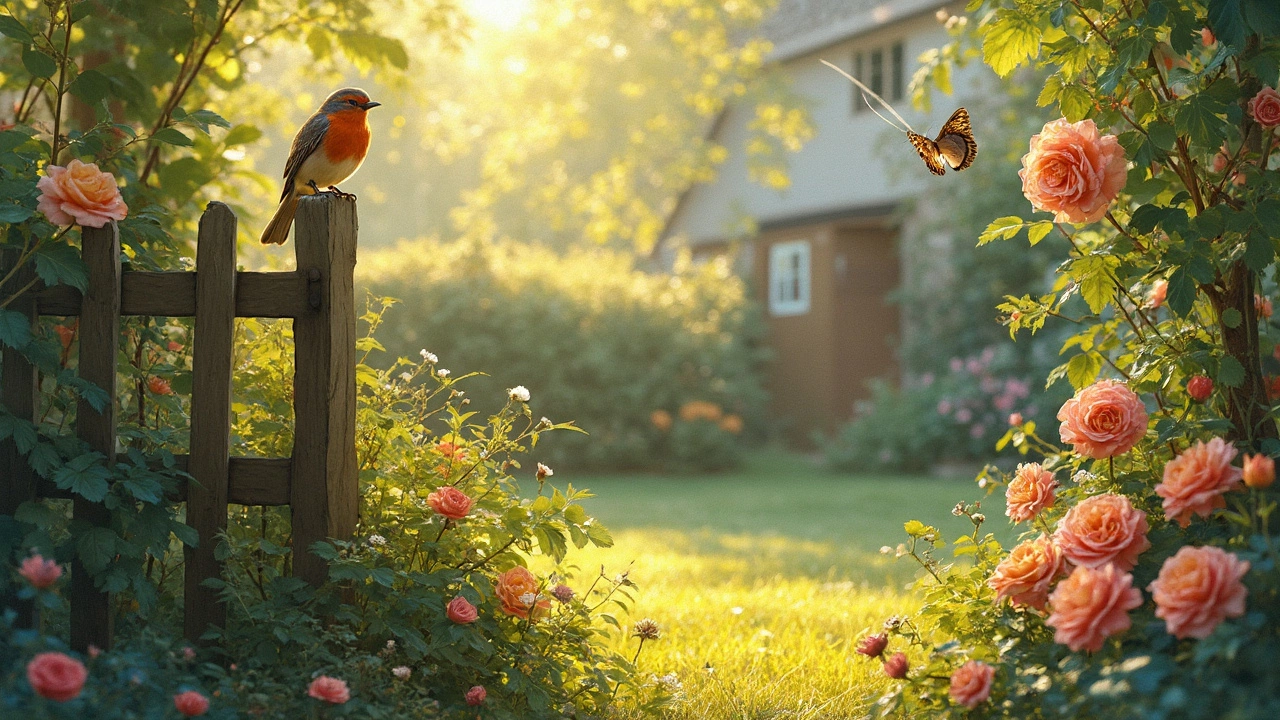When your beloved plants start looking a little ragged, it might be time to play detective and track down some sneaky culprits. First thing's first—check those leaves. If you've got holes, there's a good chance something's been munching away. Caterpillars, beetles, and slugs are usual suspects, and each leave a distinct mark.
Another telltale sign? Droppings or trails. Slugs and snails, for example, leave a shiny slime trail in their wake. Finding these means you've got a night-time visitor on your hands. Meanwhile, other pests like caterpillars leave droppings that look like tiny black pellets.
Then there's behavior. Some pests, like aphids and whiteflies, tend to cluster on new growth and underside leaves. Keep an eye out for leaf curling or yellowing – it could be a sign of these sap-sucking insects.
- Recognizing Leaf Damage
- Spotting Droppings and Trails
- Understanding Pest Behavior
- Quick Remedies and Prevention Tips
Recognizing Leaf Damage
Identifying garden pests often begins with a close look at the leaves on your plants. Damaged leaves are one of the first signs that something is amiss. Let’s dive into what those signs might tell you about the intruders causing the ruckus in your garden.
Common Signs of Leaf Damage
Leaf damage comes in all shapes and sizes, much like the pests themselves. Here are some patterns to look for:
- Holes in Leaves: Circular or irregular holes often point to caterpillars and beetles. Grab a flashlight at dusk, and you might catch them in the act.
- Chewed Edges: Ragged edges on leaves usually suggest grasshoppers or beetles have been snacking.
- Skeletonized Leaves: When the leafy tissue is gone but veins remain, think of slugs or certain beetle larvae.
Specific Pest Culprits
Matching damage type to the right pest can help tailor your pest control strategy. Here’s a quick reference:
| Damage Type | Possible Pest |
|---|---|
| Holes in the center | Caterpillars, beetles |
| Leaf curling | Aphids |
| Sticky residue | Aphids, whiteflies |
Troubleshooting and Solutions
Once you've zeroed in on the pest control offenders, it’s time to take action:
- Identify: Examine the damage and try to spot the pest.
- Research: Look up control methods for the identified intruder.
- Implement: Use a targeted approach such as picking off caterpillars by hand, using neem oil for aphids, or setting up barriers for slugs.
Keep in mind, early detection and action are key. Regularly inspect your plants to get ahead of potential problems and keep your garden healthy and thriving.
Spotting Droppings and Trails
Ever walked into your garden and spotted mysterious trails or droppings? These are important clues that help us identify specific garden pests. Observing these signs can tell you who's been browsing your plants long after they've scuttled away.
Slime Trails
Let's start with something not-so-secretive: slime trails. If you find glistening marks on the ground or your plant leaves, you're dealing with slugs or snails. These night-time roamers leave behind a trail that sparkles in sunlight, acting like a breadcrumb path to trace their munching adventures.
Mystery Droppings
Next up, those tiny black pellets you stumbled on this morning. Caterpillars and slugs are infamous for leaving droppings that often collect on leaves or fruit. The droppings are small, so inspect closely, especially if you notice chewed foliage. Unlike their delicate appearance, caterpillars can be shockingly productive eaters!
For a more organized approach to their identification:
- Caterpillars: Look for green or brown droppings on leaves and stems.
- Slugs: They leave darker, moist waste that sometimes blends with soil, so look around plant bases.
Webbing or Silk
If you see spun webs on leaves or between stems, you've got another suspect: spider mites or caterpillars. While not droppings or trails in the traditional sense, webs are just as informative, indicating these pests' presence and giving you a chance to act before they cause significant damage.
By keeping an eye out for these signs, you can identify and address garden pests quickly. This awareness helps maintain the health of your plants and aids in developing better pest control strategies.

Understanding Pest Behavior
Ever wonder what makes these pesky critters tick? Understanding pest behavior is crucial if you want to get the upper hand in your garden. Each garden pest has its quirks, and noticing these can help you catch them early before they do real damage.
The Tiny Terror: Aphids
Aphids, those tiny green pests, are a real pain in the neck. They love hanging around on the underside of leaves where they're not easily seen. They're usually attracted by juicy new growth, sucking out the plant's sap and leaving behind sticky honeydew, which can attract ants or foster mold. These sneaky critters multiply fast, especially in warm weather, so keep a close watch!
Night Raiders: Slugs and Snails
Sluggish by day, these night-shifters come out after dusk to chomp on your leaves. They're drawn by moisture and really take a liking to tender plants like hostas. If you've got a slug issue, check in the evening or early morning. Their slimy trails are a dead giveaway that you've got a snail or slug problem.
Leaf Miners: Hidden Intruders
Leaf miners are so small, often only 1/10 of an inch long, that you'll likely notice their damage before the miners themselves. They tunnel through leaves, leaving behind squiggly lines that look like something out of a doodle sketch. They're usually more interested in ornamentals and vegetables, so if your spinach or beat leaves look off, a miner might be the culprit.
Statistical Insight: Common Pest Stats
Just how widespread are these problems? Check out this quick look below:
| Pest Type | Common Host Plant | Life Cycle Duration |
|---|---|---|
| Aphids | Broad Range: Roses to Vegetables | 7-10 days |
| Slugs/Snails | Hostas, Broccoli, Lettuce | 1 year (overwintering) |
| Leaf Miners | Spinach, Beets, Chard | 2-4 weeks |
By knowing these behaviors and patterns, you can gear up better defenses. Regular checks and understanding what they're up to can save a lot of trouble down the road.
Quick Remedies and Prevention Tips
Got garden pests but don't want to use harsh chemicals? No problem. There are plenty of natural and effective ways to keep your garden pest-free. Here are some quick fixes and preventative measures to consider.
Natural Remedies
- Neem Oil: This natural pesticide is a great option for controlling bugs like aphids and whiteflies. Simply mix with water and spray your plants as needed.
- Soap Spray: A simple mixture of water and a bit of dish soap can do wonders against soft-bodied insects. Cover your plant leaves with this mix, but wash it off after a few hours to avoid leaf damage.
- Coffee Grounds: Spread them around your plants. The caffeine and strong smell can deter slugs and ants effectively.
Preventative Strategies
Prevention is key in garden pest control. By taking these steps, you can keep the critters from causing havoc in the first place.
- Companion Planting: Some herbs and flowers naturally repel pests. For example, plant marigolds to ward off nematodes or basil to deter flies and mosquitoes.
- Regular Monitoring: Keep an eye on your plants regularly. Catching an outbreak early can save you a ton of trouble later.
- Healthy Soil: Maintain healthy soil with good drainage and proper nutrients. Healthy plants are less likely to suffer pest infestation.
Useful Stats
| Pest | Natural Deterrent |
|---|---|
| Aphids | Neem Oil |
| Snails | Coffee Grounds |
| Beetles | Companion Planting |
Remember, understanding and being able to effectively identify garden pests gives you the upper hand. These tips will help you create a thriving garden brimming with life and free from pesky intruders.
